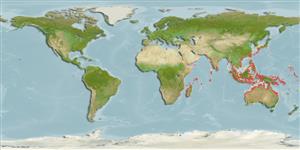Florideophyceae |
Gigartinales |
Areschougiaceae
Environment: milieu / climate zone / depth range / distribution range
Ecology
Sessile. Tropical
Indian Ocean: in Malaysia and Singapore; Pacific Ocean: in China and Japan, south to the South China Sea (Viet Nam and Philippines).
Length at first maturity / Size / Weight / Age
Maturity: Lm ? range ? - ? cm
Thalli form thick clumps, consisting of many clavate branches with slightly acute apices. Branches are densely covered with simple or compound spinose tubercles, regularly arranged into distinct nodes and internodes, forming verticils at the nodes; the verticils overlap at the distal portion of the branches so that the verticillate arrangement is obscured. Cross- section of a branch reveals a medulla composed of large rounded cells interspersed with smaller cells. Cortical cells very small, ovoid or elongated. Thalli up to 15 cm in height (Ref. 80758). It is easily mistaken for a live coral because of its close resemblance to corals of the genus Acropora (Ref. 80758).
Utilized for human consumption; a source of carrageenan (Ref. 80758). Grows on live corals, algal limestones or basalt substrates in close association with living hard and soft corals in lower intertidal to upper subtidal reef areas where the current is swift and the water free from silt (Ref. 80758)
Life cycle and mating behavior
Maturity | Reproduction | Spawning | Eggs | Fecundity | Larvae
Guiry, M.D. and G.M. Guiry 2009 AlgaeBase. World-wide electronic publication, National University of Ireland, Galway. http://www.algaebase.org; searched on 14 April 2009. (Ref. 80701)
IUCN Red List Status
(Ref. 130435: Version 2025-1)
CITES status (Ref. 108899)
Not Evaluated
Not Evaluated
Threat to humans
Human uses
Fisheries: commercial
| FishSource |
Tools
More information
Trophic EcologyFood items (preys)
Diet composition
Food consumption
Predators
Population dynamicsGrowth
Max. ages / sizes
Length-weight rel.
Length-length rel.
Length-frequencies
Mass conversion
Abundance
Life cycleReproduction
Maturity
Fecundity
Spawning
Eggs
Egg development
Larvae
PhysiologyOxygen consumption
Human RelatedStamps, coins, misc.
Internet sources
Estimates based on models
Preferred temperature
(Ref.
115969): 27.3 - 29.3, mean 28.7 (based on 1768 cells).
